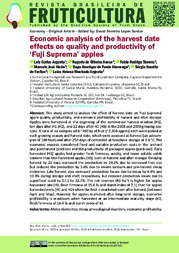Economic analysis of the harvest date effects on quality and productivity of Fuji Suprema apples.
Economic analysis of the harvest date effects on quality and productivity of Fuji Suprema apples.
Author(s): ARGENTA, L. C.; ANESE, R. de O.; THEWES, F. R.; VIEIRA, M. J.; ALVARENGA, T. H. de P.; FREITAS, S. T. de; ARGENTA, L. H. M.
Summary: This study aimed to analyze the effect of harvest date on ‘Fuji Suprema’ apple quality, productivity, and economic profitability at harvest and after storage. Apples were harvested at the beginning of the commercial harvest window (H1), ten days after H1 (H2), and 22 days after H1 (H3) in the 2008 and 2009 growing seasons. A total of six samples with ~400 kg of fruit (~2,900 apples) each were picked at each growing season and harvest date, which were assessed at harvest (six subsamples of 100 fruit) and after 250 days of controlled atmosphere storage at 0.8 °C. The economic analysis considered fixed and variable production costs in the orchard and postharvest practices and the productivity of packaged apples (pack-out). Early harvested (H1) apples had greater flesh firmness, acidity, and lower soluble solids content than late-harvested apples (H3), both at harvest and after storage. Delaying harvest by 22 days increased the production by 10.2% due to increased fruit size but reduced the production by 3.6% due to severe sunburn and pre-harvest decay incidence. Late harvest also increased production losses due to decay by 4.4% and 10.9% during storage and shelf, respectively, but reduced production losses due to superficial scald by 17.1 to 22.7%. The net revenue (R$ ha-1) is higher for apples harvested late (H3, flesh firmness of 15.6 lb and starch index of 7.1) than for apples harvested early (H1 and H2) when the fruit is marketed soon after harvest (between April and May). However, for apples marketed after long-term storage, economic profitability is maximum when harvested at an intermediate maturity stage (H2, flesh firmness of 16.4 lb and starch index of 6).
Publication year: 2024
Types of publication: Journal article
Unit: Embrapa Semi-arid Region
Observation
Some of Embrapa's publications are published as ePub files. To read them, use or download one of the following free software options to your computer or mobile device. Android: Google Play Books; IOS: iBooks; Windows and Linux: Calibre.
Access other publications
Access the Agricultural Research Database (BDPA) to consult Embrapa's full library collection and records.
Visit Embrapa Bookstore to purchase books and other publications sold by Embrapa.

